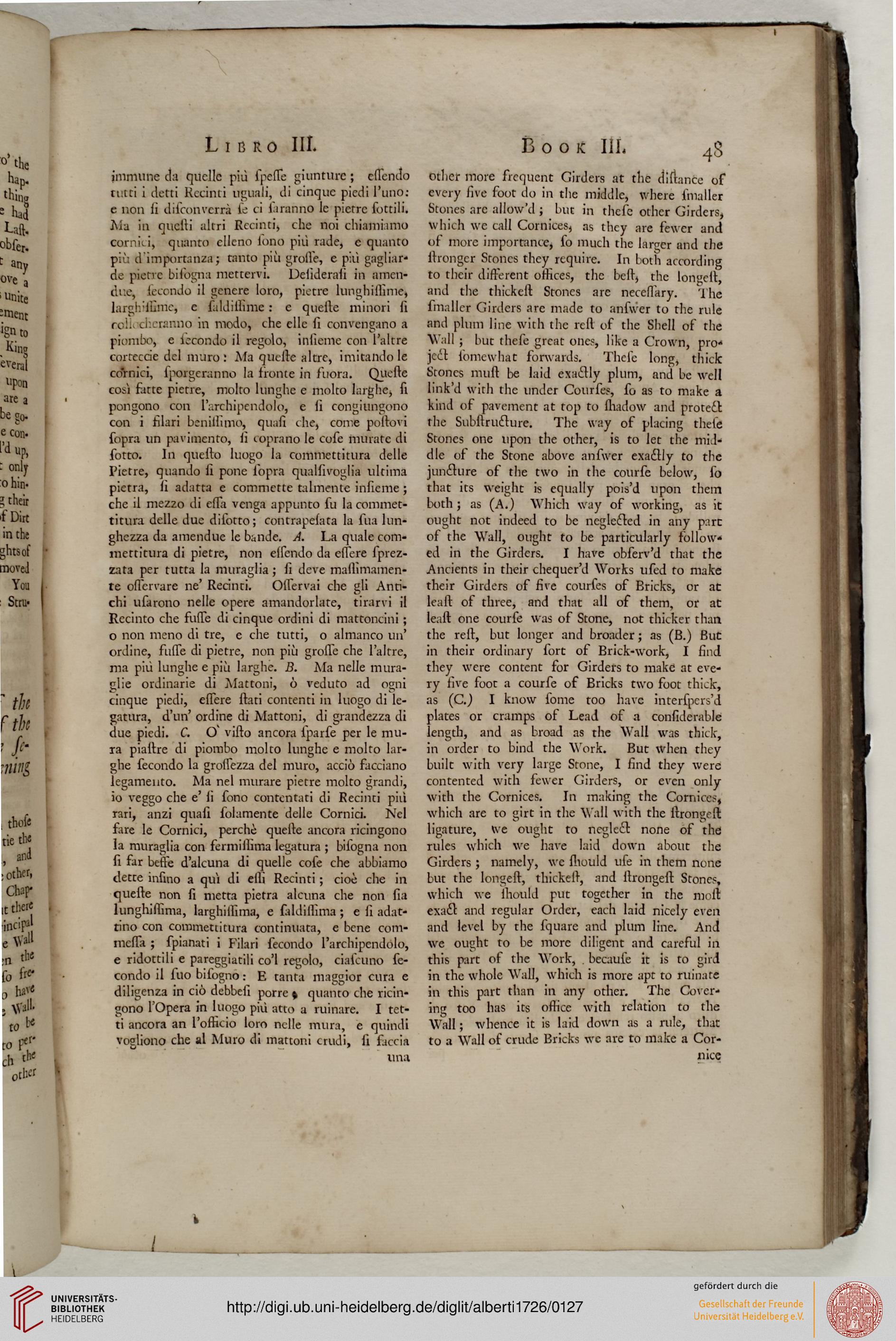Libro III.
immune da quelle più ipesse giunture ; ossendo
tutti i delti Recinti usuali, di cinque piedi l'uno:
e non si drseon verrà le ci ("iranno le pietre Cottili.
Ma in quelli altri Recinti, che noi chiamiamo
Gamici, quanto elleno iono più rade, e quanto
più d'importanza; tanto più grolle, e più gagliar-
da piene bilogna mettervi. Deliderali in amen-
due, fecondo il genere loro, pietre lunghillìme,
larghMEme, e saldillìme : e quelle minori si
sv cheratuio in modo, che elle lì convengano a
piombo, e lecondo il regolo, insicine con l'altre
concede del muro : Ma quelle altre, imitandole
consici, sporgeranno la fronte in fuora. Quelle
cosi fatte pietre, molto lunghe e molto larghe, si
pongono con l'archipendolo, e lì congiungono
con i filari benilhmo, quasi the, come poitovi
sopra un palamento, i\ coprano le cose mutate di
sotto. In quello luogo la commettitura delle
Pietre, quando si pone sopra qualsivoglia ultima
pietra, il adatta e commette talmente insicine ;
che il mez2o di ella venga appiano su la commet-
titura delle due difetto; contrapelata la sila lun-
ghezza da amendue le bande. A. La quale com-
mettitura di pietre, non elsendo da essere sprez-
zata per tutta la muraglia; iì deve mallimamen-
te osicn'are ne' Recinti. OlTervai che gli Anti-
chi tisarono nelle opere amandorlate, tirarvi il
Recinto che fusie di cinque ordini di mattoncini ;
o non meno di tre, e che tutti, o almanco un'
ordine, fuste di pietre, non più grosse che l'altre,
ma più lunghe e più larghe. B. Ma nelle mura-
glie ordinarie di Mattoni, ò veduto ad ogni
cinque piedi, essere flati contenti in luogo di le-
gatura, d'un' ordine di Mattoni, di grandezza di
due piedi. C. O' villo ancora sparse per le mu-
ra piatire di piombo molto lunghe e molto lar-
ghe secondo la grolsezza del muro, acciò facciano
legamento. Ma nel murare pietre molto grandi,
io veggo che e' si sono contentati di Recinti più
rari, anzi quasi solamente delle Cornici. Nel
fare le Cornici, perchè quelle ancora ricingono
la muraglia con fermishma legatura ; bilogna non
si far beffe d'alcuna di quelle cose che abbiamo
dette insino a qui di elsi Recinti ; cioè che in
quelle non si metta pietra alcuna che non sia
lunghiisima, larghilsima, e saldiilìma ; e si adat-
tino con commettitura continuata, e bene com-
mena ; spianati i Filari secondo l'archipendolo,
e ridottili e pareggiatili co'l regolo, ciaseuno se-
condo il suo bisogno : E tanta maggior cura e
diligenza in ciò debbesi porre ; quanto che ricin-
gono l'Opera in luogo più atto a ruinare. I tet-
ti ancora an l'officio loro nelle mura, e quindi
vogliono che al Muro di mattoni crudi, si saccia
lina
Book HI,
4S
other more frequent Girders at the diflance of
every sive foot do in the middle, where smallet
Stones arc allow'd ; but in these other Girders,
which we call Cornices, as they are fewer and
of more importance, so much the larger and the
stronger Stones they require. In both according
to their different osfices, the bed, the lon«cll,
and the thickell Stones arc necesiary. The
(mailer Girders arc made to answer to the rule
and plum line with the rest of the Shell of the
Wall ; but these great ones, like a Crown, pro-
ject somewhat forwards. These long, thick
Stones mud be laid exassly plum, and be well
link'd with the under Courses, so as to make a
kind of pavement at top to shadow and protedt
the Substruclure. The way of placing these
Stones one upon the other, is to let the mid-
dle of the Stone above answer exacily to the
juncture of the two in the course below, so
that its weight is equally pois'd upon them
both ; as (A.) Which way of working, as it
ought not indeed to be neglefled in any p:;rc
of the Wall, ought to be particularly sollow»
ed in the Girders. I have observ'd that the
Ancients in their chequer'd Works used to make
their Girders of five courses of Bricks, or at
leali of three, and that all of them, or at
leali one course was of Stone, not thicker than
the rest, but longer and broader ; as (B.) But
in their ordinary sort of Brick-work, I find
they were content for Girders to make at eve-
ry five foot a course of Bricks two foot thick,
as (C.) I know some too have interspers'd
plates or cramps of Lead of a considerable
length, and as broad as the Wall was thick,
in order to bind the Work. But when they
built with very large Stone, I find they were
contented with fewer Girders, or even only
with the Cornices. In making the Cornices,
which are to girt in the Wall with the ilronge st
ligature, we ought to negleft none of the
rules which we have laid down about the
Girders ; namely, we should use in them none
but the longest, thickell, and llrongeil Stones,
which we should put together in the niost
exafl and regular Order, each laid nicely even
and level by the square and plum line. And
we ought to be more diligent and careful in
this part of the Work, . because it is to gird
in the whole Wall, which is more apt ro ruinate
in this part than in any other. The Cover-
in" too has its osfice with relation to the
Wall ; whence it is laid down as a rule, that
to a Wall of crude Bricks wc are to make a Cor-
nice




